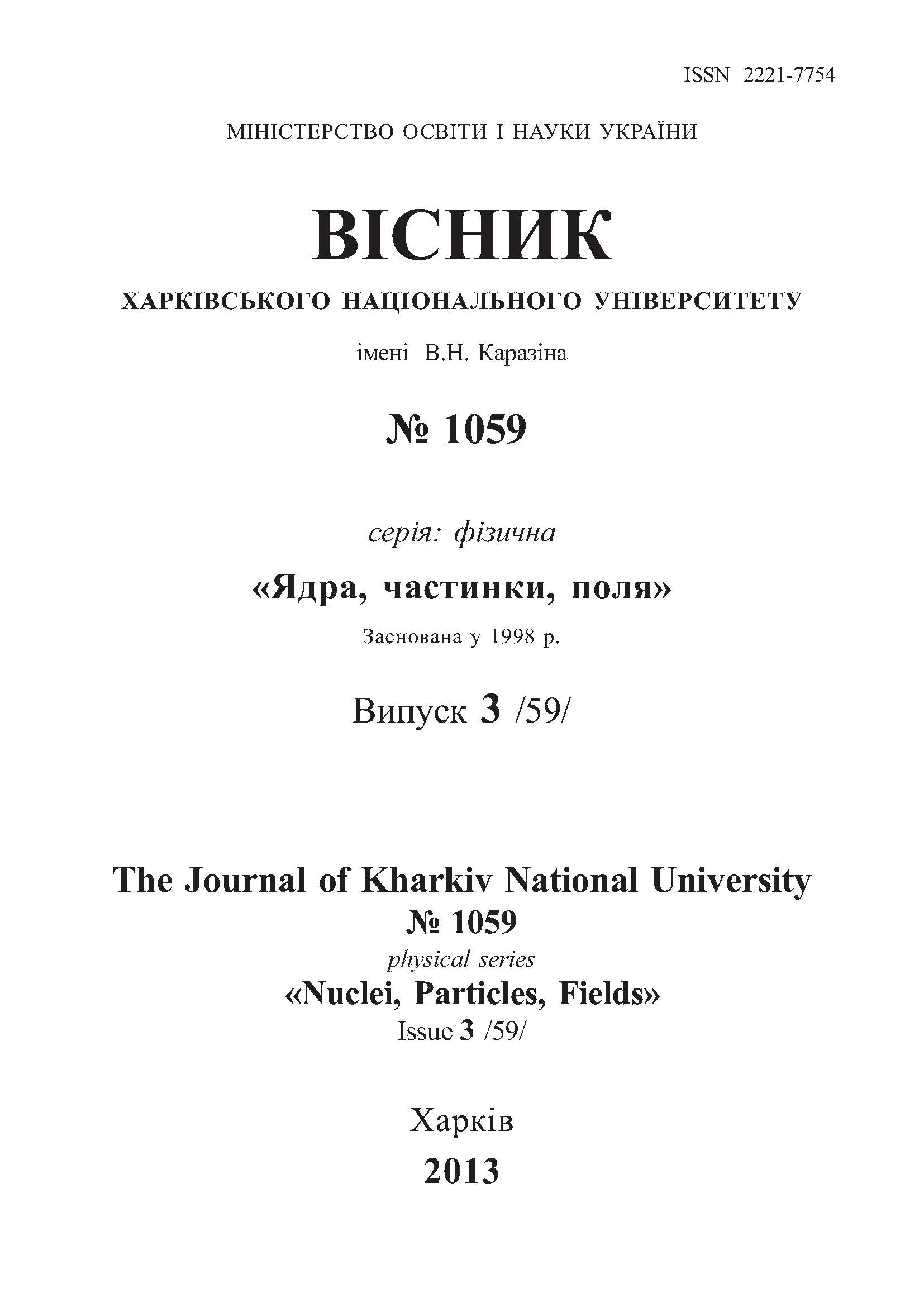The Structure and EPR Of The Lowsize Powders KNb1-XFeXO3
Abstract
The compounds of KNb1-xFexO3 system (at 0.01 < х < 0.8), synthesized by a technique of oxidation of metal in molten potassium nitrate with the addition of potassium hydroxide, have been investigated by means of XRD, SEM and EPR methods. Homogeneity range and solubility limit of iron have been established. The XRD data showed that in the compositions with x>0.2, in addition to the solid solution, an impurity phase a-Fe2O3 is emerged. In the EPR spectra even at х=0.05, a ferromagnetic resonance signal at g=2.004 is registered, which presumably also corresponds to a-Fe2O3 phase. In the compositions with x=0.1 and above, another ferromagnetic signal at g »15 arises, which may corresponds to the formation of a-Fe clusters.
Downloads
References
Лайнс М., Гласс А. Сегнетоэлектрики и родственные им материалы. - М.: Мир, 1981. – 286c.; Matthias B.T., Remeika J.P., // Phys. Rev. – 1951. – Vol.82. – P.727.
Gunter P. Holography, Coherent Light Amplification, and Optical Phase Conjugation with Photorefractive Materials // Phys. Rep. – 1982. – Vol.93. – P.199.
Chun M.K., Goldberg L., Weller J.F. Second‐harmonic generation at 421 nm using injection‐locked GaAlAs laser array and KNbO3 // Appl. Phys. Lett. – 1988. – Vol. – 53. – Iss.13. – P.1170.
Goldberg L., Busse L., Mehusy D. Blue light generation by frequency doubling of AlGaAs broad area amplifier emission // Appl. Phys. Lett. – 1992. – Vol.60. – Iss. 9. – P.1037.
Cho Y., Oota N., Odagawa H., Yamanouchi K. Quantitative study on the nonlinear piezoelectric effect in KNbO3 single crystals for a highly efficient surface acoustic wave elastic convolver // J. Appl. Phys. – 2000. – Vol.87. – P.3457.
Nagata H., Matsumoto K., Hirosue T., Hiruma Y., Takenaka T. Fabrication and Electrical Properties of Potassium Niobate Ferroelectric Ceramics // Jpn. J. Appl. Phys. – 2007. – Vol.46. – P.7084-7088.
Za M., Gunter P. Nonreciprocal optical transmission through photorefractive KNbO3:Mn // Opt. Lett. – 1085. – Vol.10. –P.184-186.
Ding Y., Zhang Z.G., Eichler H.J., Shen D.Z., Ma X.Y., Chen J.Y. Mirrorless self-pumped phase conjugation in KNbO3:Mn and KNbO3:Co // Opt. Lett. – 1995. – Vol.20. – P.686.
Zhang Z., Ding Y., Eichler H.J., Fu P., Zhou G., Yang J.. Shen D., Ma X., Chen J. Improvement of the Two-Beam Response Time in Photorefractive Double-Doping KNbO3 // Chinese Physics Letters. – 1997. – Vol.14. – P.103.
Kakimoto K.I, Masuda I., Ohsato H. Solid-Solution Structure and Piezoelectric Property of KNbO3 Ceramics Doped with Small Amounts of Elements // Jpn. J. Appl. Phys. – 2004. – Vol.43. – P.6706-6710.
Masuda I., Kakimoto K.I., Ohsato H. Ferroelectric Property and Crystal Structure of KNbO3 Based Ceramics // Journal of Electroceramics. – 2004. – Vol.13. – P.555-559.
Matsumoto K., Hiruma Y., Nagata H., Takenaka T. Electric-field-induced strain in Mn-doped KNbO3 ferroelectric ceramics // Ceramics International. – 2008. – Vol.34. – P.787–791.
Nagata H., Hirosue T., Hikita K., Hiruma Y., Takenaka T. Evaluation of Piezoelectric Properties for KNbO3-Based Ceramics // Ferroelectrics. – 2009. – Vol.381. – P.191-195.
Nagata H., Yawata N., Sato S., Takenaka T. Fabrication and Electrical Properties of Mn-Doped KNbO3 Ceramics Synthesized from KHCO3 as a Starting Material // Japanese Journal of Applied Physics. – 2012. - Vol.51. – P.09LD05.
Golovina I.S., Bryksa V.P., Strelchuk V.V., Geifman I.N., Andriiko A.A. Size effects in the temperatures of phase transitions in KNbO3 nanopowder // J. Appl. Phys. – 2013. – Vol.113. – P.144103.
Raikhler Yu.L., Stepanov V.I. Intrinsic magnetic resonance in superparamagnetic systems // Phys. Rev. – 1995. – Vol.B 51. – P.16428.
Pietrzak J., Klimaszewski B. Ferromagnetic Resonance in Thermally Processed α-Fe2O3 // Phys. Status Solidi. -1969. – Vol.B 34. – P.315–318.
Mukherjee S., Pal A.K., Bhattacharya S., Chattopadhyay S. Field-induced spin–flop transitions of interacting nanosized α-Fe2O3 particles dispersed in a silica glass matrix // J. Phys.: Condens. Matter. – 2008. – Vol. 20. – P.055204.
Hseih C.T, Huang W.L, Lue J.T, The change from paramagnetic resonance to ferromagnetic resonance for iron nanoparticles made by the sol–gel method // Journal of Physics and Chemistry of Solids. – 2002. – Vol.63. – P.733–741.
Jahagirdar A.A., Dhananjay N., Monika D.L., Kesavulu C.R., Nagabhushana H., Sharma S.C., Nagabhushana B.M., Shivakumara C., Rao J.L., Chakradhar R.P.S. Structural, EPR, optical and magnetic properties of -Fe2O3 nanoparticles // Spectrochimica Acta Part A: Molecular and Biomolecular Spectroscopy. – 2013. – Vol.104. – P.512–518.
Can M.M., Coşkun M., Fırat T. A comparative study of nanosized iron oxide particles; magnetite (Fe3O4), maghemite (γ-Fe2O3) and hematite (α-Fe2O3), using ferromagnetic resonance // Journal of Alloys and Compounds. – 2012. – Vol.542. – P.241–247.
Golovina I.S., Shanina B.D., Kolesnik S.P., Geifman I.N., Аndriiko А.А. Magnetic defects in KTaO3 and KTaO3:Fe nanopowders // Phys. Stat. Sol. B. – 2012. – Vol.249. – P.2263–2271.
Folly W.S.D., Caffarena V.R., Sommer R.L., Capitaneo J.L., Guimaraes A.P. Magnetic properties of Fe90Zr7B3 ribbons studied by FMR and magnetization // Journal of Magnetism and Magnetic Materials. – 2008. – Vol.320. – P.e358–e361.
Rivoire M., Suran G. Magnetization of thin films with in-plane uniaxial anisotropy studied by microwave absorption // J. Appl. Phys. – 1995. – Vol.78. – P.1899-1905.
Authors who publish with this journal agree to the following terms:
- Authors retain copyright and grant the journal right of first publication with the work simultaneously licensed under a Creative Commons Attribution License that allows others to share the work with an acknowledgment of the work's authorship and initial publication in this journal.
- Authors are able to enter into separate, additional contractual arrangements for the non-exclusive distribution of the journal's published version of the work (e.g., post it to an institutional repository or publish it in a book), with an acknowledgment of its initial publication in this journal.
- Authors are permitted and encouraged to post their work online (e.g., in institutional repositories or on their website) prior to and during the submission process, as it can lead to productive exchanges, as well as earlier and greater citation of published work (See The Effect of Open Access).








